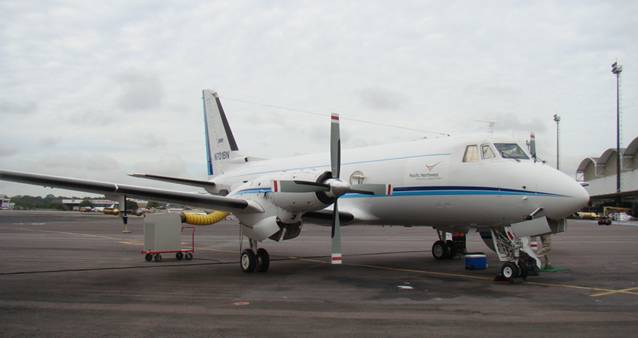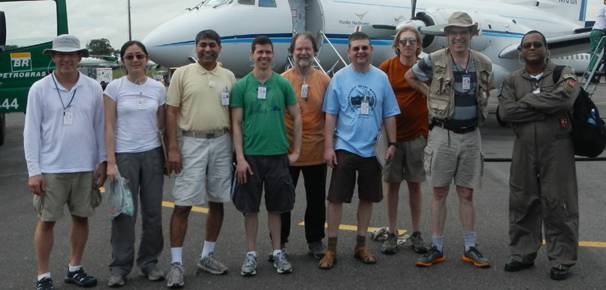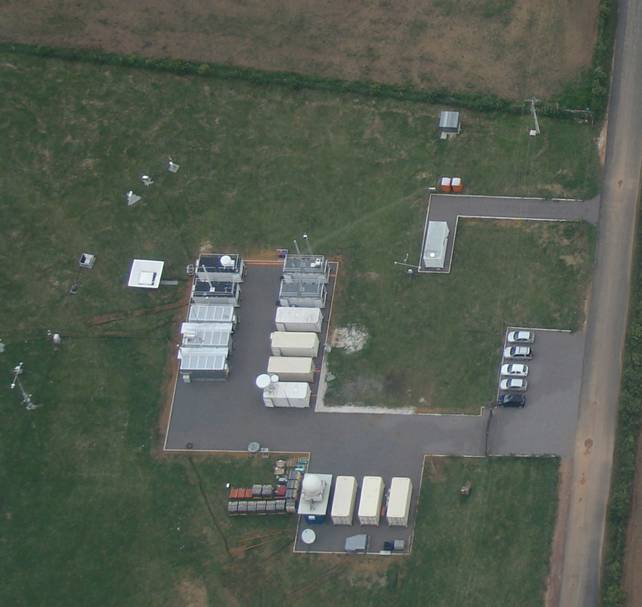Editor’s note: Stephen R. Springston, a scientist at Brookhaven National Laboratory and an instrument mentor for ARM’s Aerosol Observing System, sent this update.
 G-1 flight #1 has successfully been completed! Here’s the big white bird waiting for ARM Aerial Facility (AAF) crew and SOBs, or Scientists on Board, (to the right):
G-1 flight #1 has successfully been completed! Here’s the big white bird waiting for ARM Aerial Facility (AAF) crew and SOBs, or Scientists on Board, (to the right):
Left to right:
- John Hubbe, flight scientist, Pacific Northwest National Laboratory (PNNL)
- Fan Mei, aerosol mentor and flight support, PNNL
- Duli Chand, aerosol instrument mentor, PNNL
- John Shilling, scientific crew and instrument mentor, PNNL

- Dan Nelson, flight support and pump rebuilder extraordinaire, PNNL
- Beat Schmid, AAF Technical Director, PNNL
- Jason Tomlinson, scientific crew and instrument mentor, PNNL
- Stephen Springston, scientific crew and instrument mentor, BNL
- Airman Delsio, liaison, Brazilian Airforce
Flight Crew (not shown): Mike Hubbell (chief pilot) and Clayton Eveland (copilot) both of PNNL.
 Flight went from 14:36 to 17:25 UTC (local Manaus time is four hours earlier) and was intended to be both a research flight for the GOAMAZON campaign and an engineering shakedown. We flew a box pattern downwind of Manaus and were treated to a view of the ARM Mobile Facility ground site in Manacapuru. Two mobile Aerosol Observing Systems (MAOS A and MAOS C) are at the top of the column of six sea containers.
Flight went from 14:36 to 17:25 UTC (local Manaus time is four hours earlier) and was intended to be both a research flight for the GOAMAZON campaign and an engineering shakedown. We flew a box pattern downwind of Manaus and were treated to a view of the ARM Mobile Facility ground site in Manacapuru. Two mobile Aerosol Observing Systems (MAOS A and MAOS C) are at the top of the column of six sea containers.
In between looking at the blinking lights and remembering how to twist the knobs on the airborne instruments, we were able to see the urban plume downwind of Manaus (we think) even though we were flying through considerable rain and vertical circulation, which tend to obscure the signal. Flight scientists, aka SOBs, all did well in the air. It was bouncy in places and we had some ‘purple’ shadows on the weather radar where we had to buckle up.
Soon after landing, we held a flight briefing and then a weather/flight planning briefing. Sunday was declared a “Hard-Down Day” where the plane and hangar are off limits and people are supposed to rest. Well, rest is a relative term. I was able to generate ‘quicklook’ data products (data plots) for my instruments. The first set is always the roughest for me. I have to remember software code I haven’t used in 6 months, then there is customization, and finally accounting for the differences in field campaign details. Processing is a challenge when everything goes right during the flight. If there are changes or non-standard conditions, it can become an exercise in tediousness.
All the best to everyone,
Stephen R. Springston

